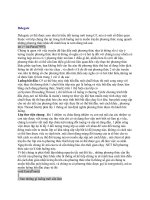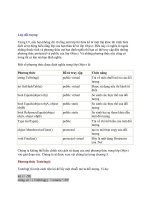C++ lecture 3
Bạn đang xem bản rút gọn của tài liệu. Xem và tải ngay bản đầy đủ của tài liệu tại đây (439.32 KB, 33 trang )
C++ Programming
Lecture 3
C++ Basics – Part I
The Hashemite University
Computer Engineering
Department
(Adapted from the textbook slides)
Outline
Introduction to C++ code.
Data types.
Identifiers.
Casting.
C++ keywords.
Memory concepts.
The Hashemite University
2
Sample C++ Program
//Sample C++ Program
/* This program prompt the user to enter two integers
and return their sum*/
#include <iostream.h>
int main()
{
int unsigned a1, a2, sum;
cout<<"Enter the first number:"; //this message will appear to the user
cout << endl;
cin >> a1;
cout<<"Enter the second number: "<< endl;
cin >> a2;
sum = a1 + a2;
cout <<"The sum of " << a1 << " and " << a2 << " = " << sum << "\n";
return 0;
}
The Hashemite University
3
Output
The Hashemite University
4
Program Explanation I
Comments:
Preprocessor directives:
Single line comment: after //
Multi-line comments: between /* and */
Comments are not processed by the compiler, feel free to
write anything you want.
Special instructions for the preprocessor.
Start with # and usually come at the beginning of the
program.
Tell the preprocessor to perform code substitutions, variables
definitions, or conditional compilation in the source code.
More about this later.
.h file:
Header file which is simply a library that includes the
definitions of the used functions within the program, i.e. the
frequently used ones to avoid repeating the code.
Two types: standard (comes with C++ package) and user
defined.
The Hashemite University
5
Program Explanation II
int main():
{ }:
Braces define a block of code.
{ is the start of this block and } is its end.
a1, a2, sum:
The main part of your program and it represents the
entry point of it.
The compiler will compile all instructions inside the
main().
So, place all instruction within the main function, i.e.
between its braces { }.
Names of variables and they are called identifiers.
int:
Define the data type of the used variable.
int means an integer
variable.
The Hashemite
University
6
Program Explanation III
cout:
cin:
Function defined in the iostream library.
An output operator.
Tells the compiler to display the string or variable value
after the insertion operator << on the screen.
cout is always followed by <<.
An input function defined in the iostream library.
Get an input usually from the keyboard.
Followed by the extraction operator >> then the variable
name in which you want to store the input value.
Input type depends on the variable type in which you store
the input.
return 0:
Tells the compiler that the main function returns 0 to the
operating system in case of successful execution of the
program.
The Hashemite University
7
Program Explanation IV
Semicolon ; :
Tells the compiler that one instruction
line has been terminated.
A large set of errors will appear if you
forget to put a semicolon at the end
of every code line in your program.
Any line of code terminated with ; is
for the compiler, preprocessor
directives do not end with ;
The Hashemite University
8
C++ Versions
The version is related to either the compiler
or the integrated development environment
(IDE) or both of them.
Versions:
Turbo C++.
Borland C++.
Visual C++.
Visual C++.Net (simply it is a higher version of visual C+
+).
All compilers provide standard C++
functions, nonstandard functions are
compiler-dependent.
Different operating systems have different
IDEs and different compilers.
The Hashemite University
9
using Statement
If you do not put .h after the library name
(like iostream library) you need to use the
using statement as follows.
using:
Eliminate the need to use the std:: prefix
Allow us to write cout instead of std::cout
To use the following functions without the std:: prefix,
write the following at the top of the program
using std::cout;
using std::cin;
using std::endl;
Or simply write the following line before main function:
using namespace std;
The Hashemite University
10
Variables Declaration
To declare a variable you must specify its name
and its data type.
All variables must be declared before they are
being used in the program. If you use a variable
not declared the compiler will give you a syntax
error.
You can place declarations in any place within
your program (but make sure to be before the
first usage of the variables) but it is preferred to
place them at the beginning of your program.
Multiple variables of the same data type can be
defined using one statement having the
variables name comma separated.
E.g.
int a, b, c;
int a = 0, b = 6, c;
The Hashemite University
11
Data Types
In mathematics there are different types of
numbers, e.g. real numbers, natural, fractions,
integers, etc.
The same concept is applied in C++, we have a
large set of data types used to define the type of
the value stored in a variable.
Why we need to define the data type of a
variable?
The compiler needs it to know the size of memory location that
will be assigned to this variable.
To define how to deal the contents of this memory location, i.e.
how to interpret it, since data is stored in memory in binary and
its data type allow the computer to convert it correctly for us.
Two types of data types in C++:
Fundamental or built-in data types.
User defined data types.
The Hashemite University
12
Fundamental Data Types -int
Integer:
Positive and negative integer values (no decimal point is
allowed).
Syntax: int number;
What will happen if you save a float number in an
integer? (storing 3.9 in number ignore everything after
the decimal point without rounding)
The range of numbers allowed to be stored in an integer
variable depends on the memory size.
short: 2 bytes signed integer.
long: 4 bytes signed integer.
signed: the most significant bit is reserved for sign.
unsigned: no negative numbers.
The Hashemite University
13
Fundamental Data Types -int
The default of int type depends on the used compiler
and the operating system under which this compiler
is work:
int a; // here ‘a’ is by default signed long integer under
VC++ (works under windows).
int a; // here ‘a’ is by default signed short integer under
Turbo C++ (works under DOS)
If you exceed the size of the variable, C++ will alter
your value where this situation is called data
overflow.
You cannot combine signed and unsigned for the
same variable and you cannot combine long and
short for the same variable.
What are the following correspond to?
signed a;
unsigned a;
short a;
The Hashemite University
14
short int a;
Fundamental Data Types -float
Floating point numbers include integers,
decimal point (fractions) and exponents (power
of 10).
Float has decimal point precision up to 6 digits.
What happen if you enter more than 6 digits
after the decimal point? (truncation)
Include both positive and negative values.
Syntax: float a;
Memory size: 4 bytes.
Exponent must be integer, i.e. 2e2.2 is not
allowed.
Examples of float numbers: 1.0, 2.5, 5e2, 0.1234
The Hashemite University
15
Fundamental Data Types -double
Same as float but with greater
range.
Syntax: double a;
Its size is 8 bytes.
The Hashemite University
16
Fundamental Data Types –
char
Character is one byte of memory used to save any
symbol, alphabet or digit number presented on the
keyboard, e.g. :, /, @, d, 5.
Syntax: char a;
char initialization:
Remember that you can initialize any variable in two ways:
Either from the keyboard by the user at runtime.
Or hardcoded in your program when you are writing the code.
From the keyboard: you must enter only one character. If you
enter more than one character for a char variable only the
first one will be taken and stored in your variable.
E.g.: What happen if you enter 199 for a character using the
keyboard?
it will store 1 and ignore the rest
Hard coding: only and only one character can be stored in a
char variable as follows:
char t = ‘a’; or char t = ‘9’;
char t = “a” // Syntax error since “a” is not only one character
The Hashemite University
17
Fundamental Data Types –
char
Character coding is used to store the
values of characters in char variable in
C++ since computers only knows binary
numbers.
Based on this coding every character
has a number value.
Coding types:
ASCII (American Standard Code for Information
Interchange). E.g. ‘a’ has the value of 97 in ASCII.
EBCDIC (Extended Binary Coded Decimal
Information Code).
Unicode : used mainly for Internet applications.
ASCII is the most dominant.
The Hashemite University
18
ASCII Table
The Hashemite University
19
Example
//Sample C++ Program, understand char concept
#include <iostream.h>
int main()
{
char qq;
cout<<"Enter a character";
cout << endl;
cin >> qq;
cout << "(int)qq is:
" << (int)qq << " and " << "qq
is: " << qq;
cout <<"\n";
return 0;
}
The Hashemite University
20
Output Example
The Hashemite University
21
Fundamental Data Types -bool
Boolean value is either true or false.
Size = 1 byte.
Syntax: bool a;
True is any non-zero value or simply true
keyword.
By any non-zero value we mean:
Any number other than zero, e.g. 9, -2, -100, 3.4, etc.
Any character (including white spaces) or string,
e.g. bool a = “Hello”; //will initialize a to be true.
False is only zero value or false keyword.
When you print a bool value on the screen,
i.e. using cout statement, it will be either 1
when true or 0 when false.
The Hashemite University
22
Data Types Ranges
Name
Bytes
(Compiler
dependent)
Description
Range (depends on number of
bytes)
char
1
Character or 8 bit integer.
signed: -128 to 127
unsigned: 0 to 255
bool
1
Boolean type. It takes only two
values.
true or false
short
2
16 bit integer.
signed: -32768 to 32767
unsigned: 0 to 65535
long
4
32 bit integer.
signed:-2147483648 to 2147483647
int
2/4
Integer. Length depends on the size
of a ‘word’ used by the Operating
system. In MSDOS a word is 2
bytes and so an integer is also 2
bytes.
Depends on whether 2/4 bytes.
float
4
Floating point number.
--
double
8
double precision floating point
number.
The Hashemite University
--
23
Casting
Casting is converting the data type
of the value of a specified variable
to another data type temporarily.
Two types of casting:
Implicit casting: done by the compiler
implicitly.
Explicit casting: need to be coded
explicitly by the programmer (to force
casting).
The Hashemite University
24
Implicit Casting
While the program is compiled or during
running, you may store values of different
data type from the data type of the variable
you are dealing with.
In some cases, the compiler do not give you
a syntax error. However, it converts the data
type of the value implicitly.
Examples:
bool num = 100; //implicitly the compiler will
convert 100 to true
int r = 3.5; //implicitly the compiler will
convert 3.5 into 3.
Note:
Implicit casting is done when needed by the complier not
when needed by you.
The Hashemite University
25









